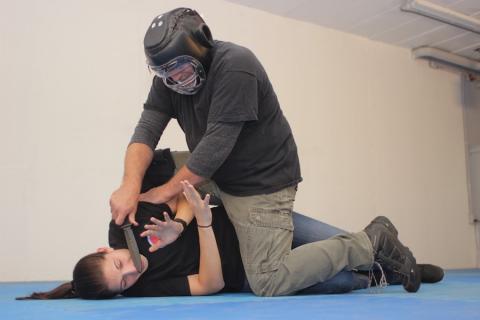The Fight
January 18, 2021
Fights are not static. Things move. People move. Bear-hugs and headlocks and all that stuff happen sometimes in a fight, but they are transitional actions. You do not get bear-hugged just to be held (except by bouncers). A Threat wraps his big arms around you from behind either to pick you up and shake you (disorienting and intended as an intimidating show of strength) or to drive you into a wall. Maybe to throw you over a balcony. If you practice technique-based defense, will they work if the Threat refuses to stand there? If he is using that headlock to slam you from wall to wall?
The Lowest Level of Force
December 7, 2020
The Records area at Rusafa Prison Complex in Baghdad is enclosed by a chain-link fence and was almost always crowded. It’s a stressful place, with inmates being processed in and out, Iraqi military, police, corrections, advocates, politicos, and sometimes families of the convicts are present and a small handful of American advisors.
Simple Drills Worth Knowing
January 30, 2017
The following are important things, some little, some major, that lend themselves well to simple drills or exercises. Backing up is almost never the answer. Unless you are excellent at reading and remembering tactical terrain, you might not know what or who is behind you.
Evaluating Drills—Part 2
October 31, 2016
I get especially annoyed with weapons. Unarmed defense against a weapon sucks. Never, ever, ever practice dying and do not train to be killed. The stakes are too high to blindly imprint a habit, even a habit as simple as handing a weapon back once you have disarmed someone.
Evaluating Drills—Part 1
October 24, 2016
I'm not a big fan of most drills. There is a fine line, but conditioned reflexes are crucial in a fight and habits will get you killed. Conditioned reflexes are things you do without thinking about it. They are essentially trained flinch responses. If something suddenly comes at your eyes you WILL do something: block, move your head or, at the very minimum, blink.
Violence Dynamics
-
May 16, 2011
Bill and I were talking to the warden in an Iraqi prison, drinking chai. A gun fired. Other than ours and the warden’s bodyguards there shouldn’t have been loaded weapons in that section of the building. I put down my tea, stood and drew my sidearm. I started clearing the building.
Self-defense: Down and Dirty
-
May 9, 2011
Let's start with one, very simple thing—power generation. A traditional martial artist is taught how to hit hard. Different systems have different methods of power generation, but two of the most common involve a solid connection with the ground and good structure.
Seize the Opportunity with Chin Na—Part 2
-
July 19, 2010
A Chin Na expert must also know how to escape from an opponent's Chin Na control, and be able to counterattack and reverse the situation. To escape from an opponent's control, you must master several techniques in addition to those explained in the previous section.
Seize the Opportunity with Chin Na—Part 1
-
July 12, 2010
Chin Na literally means "seize control." Chin Na covers a wide scale of defensive and offensive techniques, from very fundamental hand grappling to the very advanced Dim Mak. The fundamental techniques can be learned by any martial artist or even by someone without any martial arts experience.
The Seven Aspects of Self-defense
-
January 13, 2010
The following article is an excerpt from an upcoming book by Rory Miller, tentatively titled 7. It will explore the seven aspects that are critical to self defense, giving you a few hints on staying alive, or if you teach self-defense, some critical information you can pass along to your students.
Taiji Chin Na - Martial Application
-
May 4, 2009
Taijiquan was originally developed for combat in ancient times. Its fighting theory is to use the soft against the hard, and to use the round to neutralize the straight or square.
Meditations on Violence
-
May 22, 2008
People are weird. They have an almost infinite ability to learn and communicate. At the same time, this amazing ability is used as much for fantasy and entertainment as it is for information and survival. Take, for example, the rhinoceros and the unicorn.
Truly Learning Chin Na
-
January 21, 2008
Though it is very hard to catch the Chin Na techniques with 100% accuracy from a book and a video, many techniques can still be learned as long as you ponder, practice, and humbly ask.












